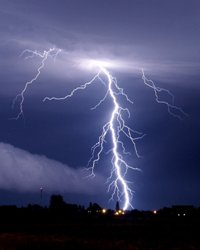How To Protect Your Electronic Equipment
(blogger@L-com.com)
As we enter the "high lightning" season, L-com likes to remind people of the dangers of leaving permanent or semi-permanent cabling installations unprotected from surges. There are a couple of parts to this overall problem. First, you have to realize the danger is with every installation of conductive material. The copper in Ethernet networking cables, or in coaxial cables that link up an antenna, or in the process control lines that prevent system failures; they all can have surges and the surges can all have the same catastrophic effects. Some people think this only happens with a direct strike, but even indirect strikes nearby can be destructive. Second, you have to take the time to find the appropriate lightning protection for your system. And third, you have to install the lightning protection properly so it is grounded.
L-com does its best to remind users of the importance of lightning protection, but their real strength and contribution is making lightning protection available and easy to research on their website and in their catalog. A lightning and surge protector for a power line is easy to find, but signal electronics tend to have unique requirements. That is because the protector must allow the signal to go through with minimal loss, but also provide iron-clad protection against transient voltages. So where do you begin?
Lightning and Surge Protector Types
A good place to start looking is L-com's Lightning Protectors Product Center on their website. Once there, look for the signal line type you are trying to protect. L-com offers solutions for each of these:
- Coaxial data cables (including cables connected to antennas)
- Coaxial video cables
- Data lines (Cat5, Cat5e, Cat6 cables typically used in Ethernet LANs)
- Phone lines (Telephone, DSL, and T1)
- RS422-485 lines (serial communication)
- Load Cell/RTD lines
- AISG/RET lines
- AC/DC Control lines
- Outdoor speakers and Public Address Systems (PA systems)
- 4-20 mA Current Loop systems
- Pivot/Tilt/Zoom (PTZ) cameras
- Permanent USB cable runs
- And several others…
Data Line and Ethernet Protectors
Among the most complicated systems to protect are the data line systems (often your premise wiring or Category rated wiring), such as the cabling that connects computers in an office to the network. There are a lot of reasons these systems require special attention:
- They are often extensive, run in walls, under floors, above ceilings, and through Plenums to every corner of a building
- They usually carry high-speed data that is very sensitive to noise and signal loss
- They sometimes have special circumstances like Power over Ethernet that have to be taken into consideration
- They can require protection in a variety of locations, including offices, industrial places, and outdoors
- Equipment on either end of a data line can be very sensitive to transient voltages and can be very expensive to replace or re-install
Finding suitable protection for your network is important and requires some strategizing. One clever resource to help you find the right protector is L-com's handy Lightning Protector Comparison Chart. This can help you zero in on the protectors that will suit you best.
Installing Lightning Protection
While L-com offers a lot of educational information about lightning protectors, they do not do installations. You may be tempted to install the lightning protectors you buy yourself, but we strongly suggest you hire or use a licensed electrician to do it. Lightning protectors are only effective if they are properly installed and grounded. Mistakes made in the installation process can nullify the protection and may even add more dangers.
sales@L-com.com.
Lightning ;)

No comments:
Post a Comment